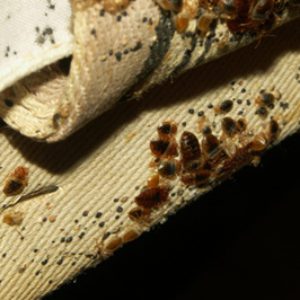So you think you might have a bed bug infestation starting to grow in your home? The first step to make sure that you identify that the bug you are looking at is in fact a true bed bug. If not addressed sooner, the bed bugs then have time to spread to more places in your home than you originally thought were infested.
A bed bug has been commonly confused with other similar looking pests such as carpet beetles, adult fleas, or lice. It is apparent that you first identify that what you are looking at is in face a bed bug.
Here are some identifying factors of adult bed bugs: 
- 1/4 inch long.
- Long and brown with a flat oval-shaped body (if not fed recently).
- Balloon-like, reddish brown and more elongated (if fed recently).
- Smelly “musty-sweetish” odor.
- Possesses characteristics of a “true-bug” which include a beak with three segments, antenna that have four parts, wings that are not used for flying, and short golden-colored hairs.
Young bed bugs (Nymphs):
- Smaller than adult bed bugs.
- Translucent or whitish-yellow in color.
- Invisible to the naked eye if not fed recently.
Bed Bug eggs:
- Size of a pinhead.
- White in color.
- Marked by an eye spot if more than five days old.
 Now that you know what kind of bug you are looking for, here are some signs that they leave around that you should pay attention to:
Now that you know what kind of bug you are looking for, here are some signs that they leave around that you should pay attention to:
- Rusty or reddish stains on bed sheets or mattresses.
- Dark spots, which are bed bug excrement and may bled on fabrics much like a marker would.
- Eggs and eggshells (which are about 1mm) and pale yellow skins that Nymphs shed as they grow bigger.
- Live bed bugs.
So now you know what kind of signs to look for, here are the places the bed bugs might be hiding:
- Seams of chairs and couches.
- Curtains.
- Drawer joints.
- Electrical appliances.
- Under loose wallpaper and wall hangings.
- Where the wall and ceiling meet.
Let us know if we can help you with any bed bug problems.
Contact us by calling (615) 220-1933 or visiting our contact page.
If you need some more information about bed bugs and signs of bed bugs.

